
These days, everyone is talking about #polarization. But how best to measure it? Olivia Fischer and I have a new paper that empirically compares various operationalizations of polarization (e.g., on people's risk perceptions), including a shiny app to simulate […]
[Original post on mstdn.science]
02.10.2025 08:13 — 👍 4 🔁 2 💬 0 📌 0

🚨 New publication out @jeppjournal.bsky.social w/ Katrin Praprotnik @luanarusso.bsky.social @markuswagner.bsky.social
We show that coalition signals from the mainstream right to the radical right shift, rather than reduce, existing political divisions.
Open-access article: doi.org/10.1080/1350...
01.10.2025 15:26 — 👍 61 🔁 24 💬 3 📌 3
This comment is the brief spiritual successor to our preprint (linked below) in which we argue much ado within debates over causal effects of social media stems from failing to account for the assumptions required by RCTs.
arxiv.org/abs/2505.09254
28.07.2025 15:41 — 👍 16 🔁 4 💬 2 📌 0
W 2-Professur für Politische Psychologie (m/w/d)
Exciting new job in Landau 🤩 We’re searching for a Professor of Political
Psychology (W2). Very much looking forward to your applications – if you
have any questions, please reach out to me. jobs.rptu.de/jobposting/3...
25.09.2025 13:59 — 👍 13 🔁 12 💬 0 📌 1
OSF
New pre-print!
Is there a need for domain-specificity when studying mental health (MH) and politics? In our study in the Netherlands, we find political mental health (PMH) is distinct from MH & has unique political correlates, from polarization to ideological extremism.
doi.org/10.31234/osf...
25.09.2025 13:56 — 👍 9 🔁 6 💬 1 📌 0

Depolarization is not "a scalable solution for reducing societal-level conflict.... achieving lasting depolarization will likely require....moving beyond individual-level treatments to address the elite behaviors and structural incentives that fuel partisan conflict" www.pnas.org/doi/10.1073/...
23.09.2025 19:59 — 👍 391 🔁 133 💬 17 📌 32

How much did Elon's takeover reshape Twitter/X? How did the partisan tilt of social media use change from 2020 to 2024?
The ANES 2024 data is out — and this thread answers all your burning questions! 🔥
16.09.2025 11:20 — 👍 42 🔁 29 💬 1 📌 2

The threat of analytic flexibility in using large language models to simulate human data: A call to attention
Social scientists are now using large language models to create "silicon samples" - synthetic datasets intended to stand in for human respondents, aimed at revolutionising human subjects research. How...
Can large language models stand in for human participants?
Many social scientists seem to think so, and are already using "silicon samples" in research.
One problem: depending on the analytic decisions made, you can basically get these samples to show any effect you want.
THREAD 🧵
18.09.2025 07:56 — 👍 326 🔁 149 💬 12 📌 58

🎓 This Friday (19.09), we are honored to welcome professor @ulrikeklinger.bsky.social to the #HotPoliticsLab! She will present her work on Facebook user reactions to party campaigning.
📍 Location: Common Room (REC-B9.22)
💻 Or join us online 👉 teams.microsoft.com/dl/launcher/...
17.09.2025 11:57 — 👍 4 🔁 4 💬 0 📌 0

🚨New pre-print🚨
"Do citizens’ views of democracy and its actors vary with how they feel?”, @lilymasonphd.bsky.social and I ask in a new paper.
Why would they? While citizens widely endorse democracy in principle, temporary factors often shape their views. Also, work on “irrelevant events"
1/8🧵
17.09.2025 15:11 — 👍 30 🔁 10 💬 1 📌 0

Abstract: Under the banner of progress, products have been uncritically adopted or
even imposed on users — in past centuries with tobacco and combustion engines, and in
the 21st with social media. For these collective blunders, we now regret our involvement or
apathy as scientists, and society struggles to put the genie back in the bottle. Currently, we
are similarly entangled with artificial intelligence (AI) technology. For example, software updates are rolled out seamlessly and non-consensually, Microsoft Office is bundled with chatbots, and we, our students, and our employers have had no say, as it is not
considered a valid position to reject AI technologies in our teaching and research. This
is why in June 2025, we co-authored an Open Letter calling on our employers to reverse
and rethink their stance on uncritically adopting AI technologies. In this position piece,
we expound on why universities must take their role seriously toa) counter the technology
industry’s marketing, hype, and harm; and to b) safeguard higher education, critical
thinking, expertise, academic freedom, and scientific integrity. We include pointers to
relevant work to further inform our colleagues.

Figure 1. A cartoon set theoretic view on various terms (see Table 1) used when discussing the superset AI
(black outline, hatched background): LLMs are in orange; ANNs are in magenta; generative models are
in blue; and finally, chatbots are in green. Where these intersect, the colours reflect that, e.g. generative adversarial network (GAN) and Boltzmann machine (BM) models are in the purple subset because they are
both generative and ANNs. In the case of proprietary closed source models, e.g. OpenAI’s ChatGPT and
Apple’s Siri, we cannot verify their implementation and so academics can only make educated guesses (cf.
Dingemanse 2025). Undefined terms used above: BERT (Devlin et al. 2019); AlexNet (Krizhevsky et al.
2017); A.L.I.C.E. (Wallace 2009); ELIZA (Weizenbaum 1966); Jabberwacky (Twist 2003); linear discriminant analysis (LDA); quadratic discriminant analysis (QDA).

Table 1. Below some of the typical terminological disarray is untangled. Importantly, none of these terms
are orthogonal nor do they exclusively pick out the types of products we may wish to critique or proscribe.

Protecting the Ecosystem of Human Knowledge: Five Principles
Finally! 🤩 Our position piece: Against the Uncritical Adoption of 'AI' Technologies in Academia:
doi.org/10.5281/zeno...
We unpick the tech industry’s marketing, hype, & harm; and we argue for safeguarding higher education, critical
thinking, expertise, academic freedom, & scientific integrity.
1/n
06.09.2025 08:13 — 👍 3038 🔁 1540 💬 96 📌 232

Radical right accommodation really does not work.
New paper out with this exceptionally talented team
@katharinalawall.bsky.social @robjohns75.bsky.social @drjennings.bsky.social @sarahobolt.bsky.social @zachdickson.bsky.social @danjdevine.bsky.social & @jack-bailey.co.uk
doi.org/10.31235/osf...
05.09.2025 06:50 — 👍 2175 🔁 987 💬 58 📌 169
If you send me your email address, I can add you to the mailing list :)
02.09.2025 07:09 — 👍 0 🔁 0 💬 0 📌 0

✨ New Academic Year, New Speaker Series! ✨
We hope you all had a wonderful summer break. We’re thrilled to announce the #HotPoliticsLab Speaker Series lineup for the first semester of the 25/26 academic year.
We look forward to welcoming you back for another year of thought-provoking discussions!
01.09.2025 12:34 — 👍 14 🔁 12 💬 1 📌 0

An ERP-study on the extent to which partisanship conditions the early processing of politicians’ faces
Partisanship has been associated with various cognitive biases. These findings are primarily based on self-reports and task performance and less on measures of neural activity. We reviewed the lite...
1/4
My first dissertation paper is now out with @bnbakker.bsky.social &
@gijsschumacher.bsky.social! Do our brains quickly encode partisan bias when simply viewing politicians’ faces?
The paper: doi.org/10.1080/1747...
Journalistic article by Psypost: www.psypost.org/early-brain-...
27.08.2025 14:02 — 👍 9 🔁 8 💬 1 📌 1

Models as Prediction Machines: How to Convert Confusing Coefficients into Clear Quantities
Abstract
Psychological researchers usually make sense of regression models by interpreting coefficient estimates directly. This works well enough for simple linear models, but is more challenging for more complex models with, for example, categorical variables, interactions, non-linearities, and hierarchical structures. Here, we introduce an alternative approach to making sense of statistical models. The central idea is to abstract away from the mechanics of estimation, and to treat models as “counterfactual prediction machines,” which are subsequently queried to estimate quantities and conduct tests that matter substantively. This workflow is model-agnostic; it can be applied in a consistent fashion to draw causal or descriptive inference from a wide range of models. We illustrate how to implement this workflow with the marginaleffects package, which supports over 100 different classes of models in R and Python, and present two worked examples. These examples show how the workflow can be applied across designs (e.g., observational study, randomized experiment) to answer different research questions (e.g., associations, causal effects, effect heterogeneity) while facing various challenges (e.g., controlling for confounders in a flexible manner, modelling ordinal outcomes, and interpreting non-linear models).

Figure illustrating model predictions. On the X-axis the predictor, annual gross income in Euro. On the Y-axis the outcome, predicted life satisfaction. A solid line marks the curve of predictions on which individual data points are marked as model-implied outcomes at incomes of interest. Comparing two such predictions gives us a comparison. We can also fit a tangent to the line of predictions, which illustrates the slope at any given point of the curve.

A figure illustrating various ways to include age as a predictor in a model. On the x-axis age (predictor), on the y-axis the outcome (model-implied importance of friends, including confidence intervals).
Illustrated are
1. age as a categorical predictor, resultings in the predictions bouncing around a lot with wide confidence intervals
2. age as a linear predictor, which forces a straight line through the data points that has a very tight confidence band and
3. age splines, which lies somewhere in between as it smoothly follows the data but has more uncertainty than the straight line.
Ever stared at a table of regression coefficients & wondered what you're doing with your life?
Very excited to share this gentle introduction to another way of making sense of statistical models (w @vincentab.bsky.social)
Preprint: doi.org/10.31234/osf...
Website: j-rohrer.github.io/marginal-psy...
25.08.2025 11:49 — 👍 941 🔁 283 💬 49 📌 19
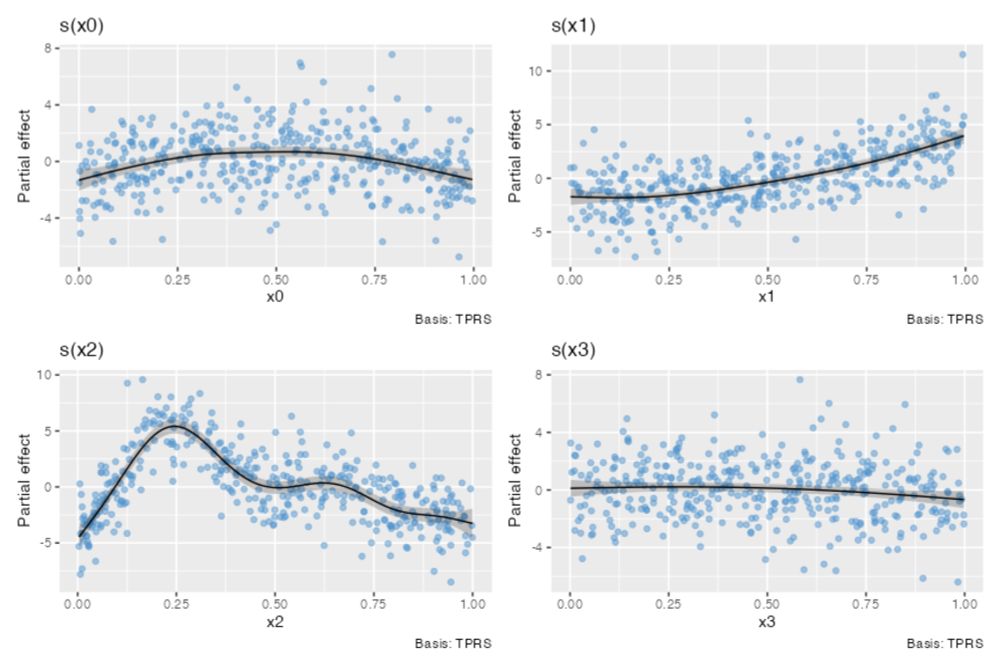
An R package for working with generalized additive models
Graceful 'ggplot'-based graphics and utility functions for working with generalized additive models (GAMs) fitted using the 'mgcv' package.
🚀 gratia 0.11.0 is out!
Now has a paper in JOSS — please cite 📄 doi.org/10.21105/jos...
Experimental parallel processing ⚡
New assemble() for building plots 🎨
Better support for complex families + new diagnostics 🧪
Lots of bug fixes + polish ✨
👉 gavinsimpson.github.io/gratia/
#Rstats
18.08.2025 18:32 — 👍 187 🔁 64 💬 3 📌 1
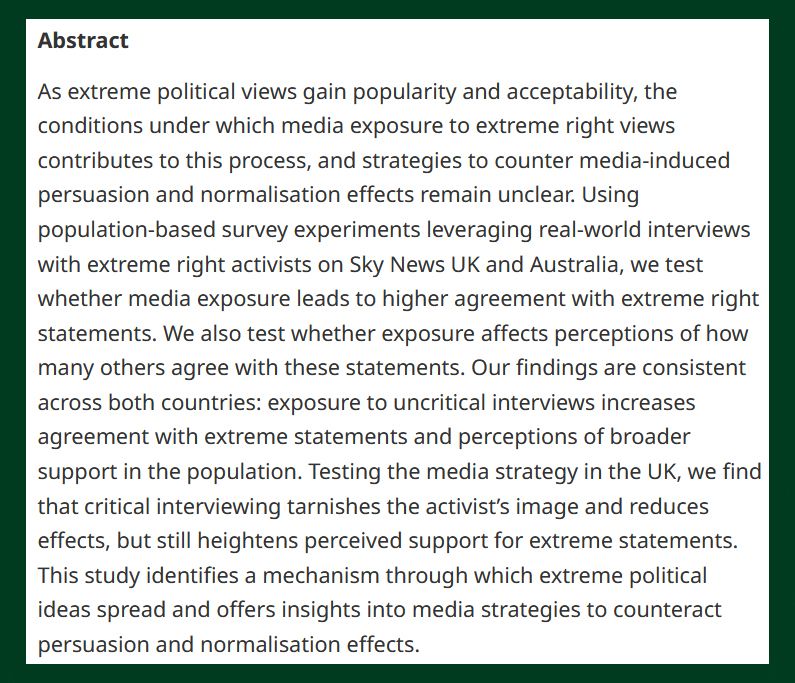
BJPolS abstract discussing the effects of extensive media exposure on public perceptions and normalization. It references specific research surveys conducted on Sky News UK and Australia, analyzing changes in public attitudes and policy effects due to media strategies.
NEW -
Media Platforming and the Normalisation of Extreme Right Views - cup.org/4mmVIAL
"exposure to uncritical interviews increases agreement with extreme statements and perceptions of broader support in the population"
- @dianebolet.bsky.social & @florianfoos.bsky.social
#OpenAccess
12.08.2025 09:05 — 👍 283 🔁 154 💬 5 📌 24
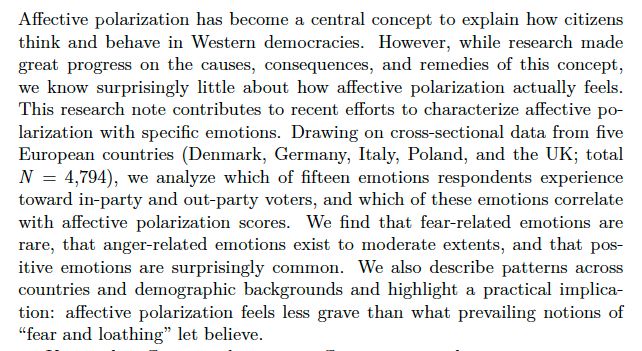
🚨Pre-print alert🚨
Research shows citizens in many Western democracies are increasingly affectively polarized––they feel warm toward their own party but quite cold toward opposing parties.
But how does it feel to “feel warmly”?
@katharinalawall.bsky.social, @mtsakiris.bsky.social & I asked.
🧵1/8
04.08.2025 11:16 — 👍 54 🔁 20 💬 3 📌 1

Paper abstract and title.
🚨New paper in @cp-trendscognsci.bsky.social 🚨
Why do some ideas spread widely, while others fail to catch on?
We review the “psychology of virality,” or the psychological & structural factors that shape information spread online and offline: authors.elsevier.com/c/1lRke4sIRv...
17.07.2025 15:27 — 👍 48 🔁 13 💬 3 📌 4
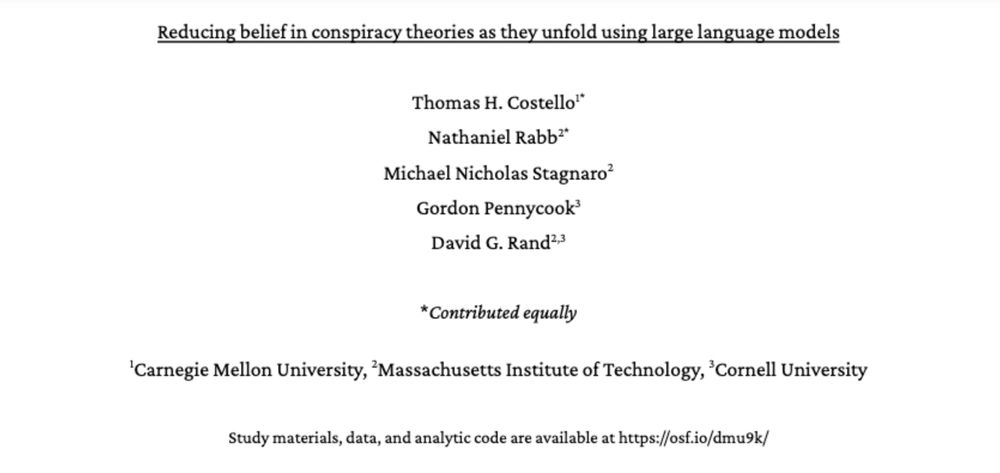
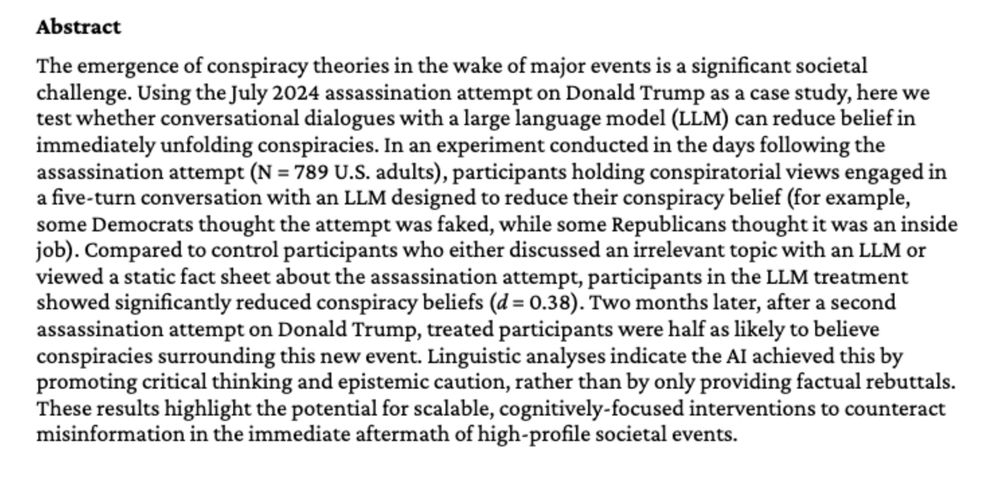
Conspiracies emerge in the wake of high-profile events, but you can’t debunk them with evidence because little yet exists. Does this mean LLMs can’t debunk conspiracies during ongoing events? No!
We show they can in a new working paper.
PDF: osf.io/preprints/ps...
09.07.2025 16:34 — 👍 51 🔁 18 💬 3 📌 2
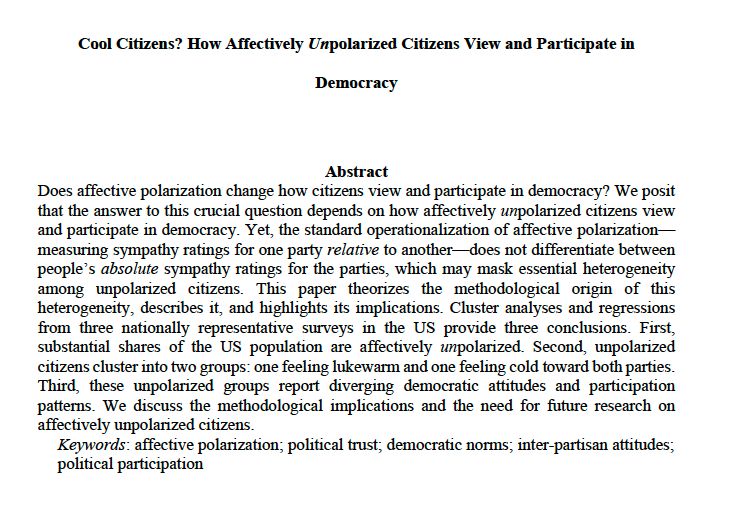
🚨Preprint alert🚨
How does affective polarization change democracy? Lots of pubs study how AP affects trust, democratic norms, inter-partisan attitudes, and participation.
We (w/ @polpsychjoe.bsky.social, @lilymasonphd.bsky.social) examine a vital assumption this research seems to rely on:
1/6🧵
24.06.2025 13:43 — 👍 54 🔁 24 💬 2 📌 2
OSF
Are we good at describing our feelings about politics? In our new preprint @mrooduijn.bsky.social @isabellareb.bsky.social we show this is not the case: osf.io/preprints/os... [1/6]
05.06.2025 11:33 — 👍 26 🔁 7 💬 1 📌 4
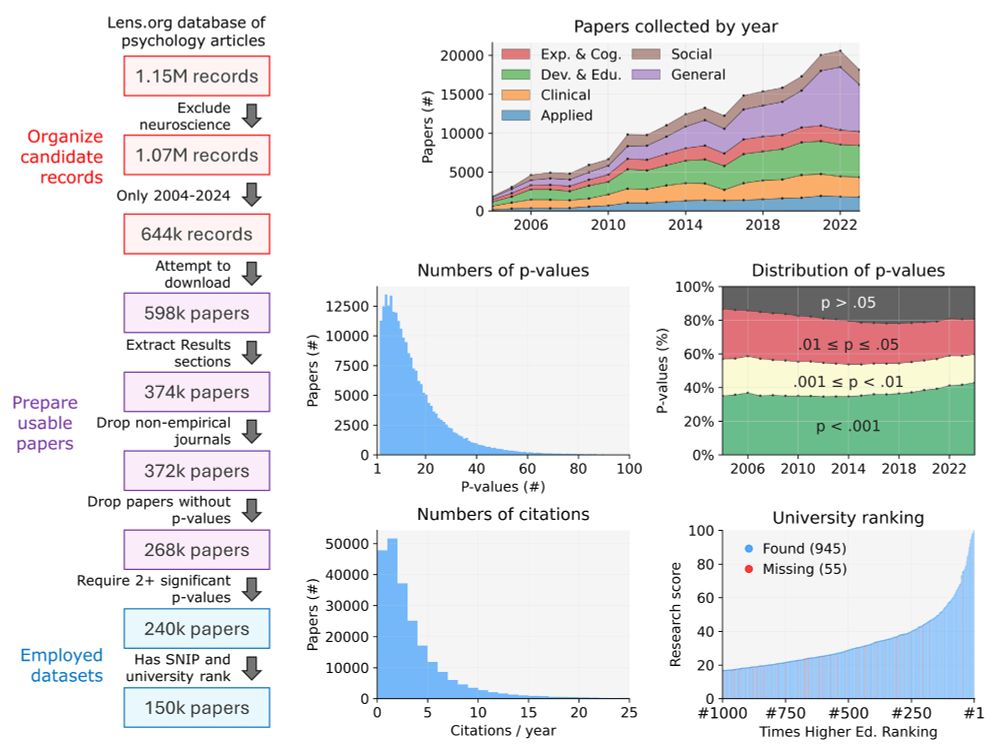
Figure 1 of the paper
🚨New paper!🚨
Meta-analysis on 4M p-values across 240k psych articles: How has psychology changed since the replication crisis began? How is replicability linked to citations, impact factor, and university prestige? 🧵
Paper: journals.sagepub.com/doi/10.1177/...
Interactive: pbogdan.com/meganal
09.04.2025 13:15 — 👍 79 🔁 37 💬 2 📌 5
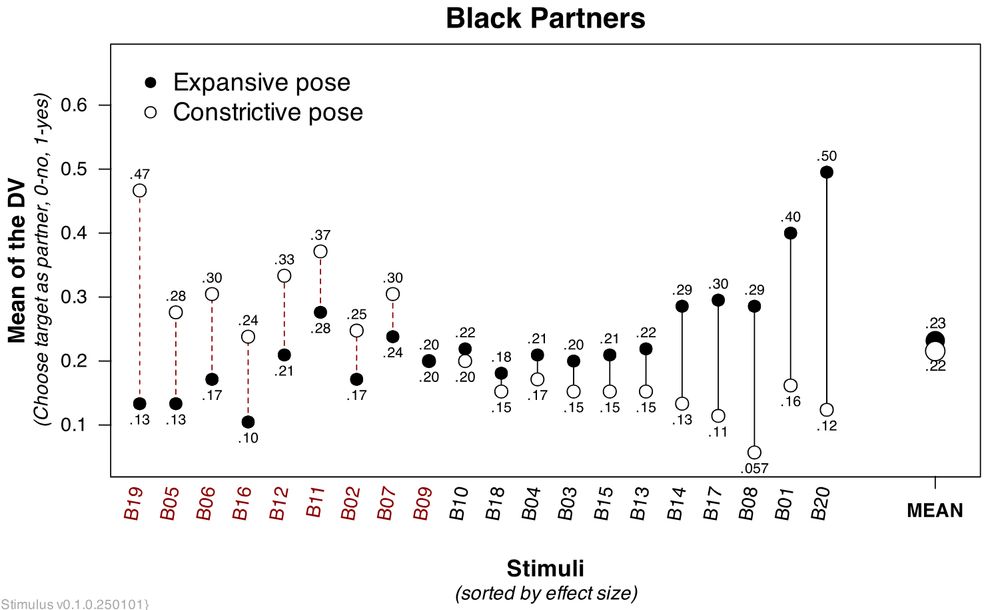
Don't assume, plot
datacolada.org/126
02.06.2025 15:37 — 👍 34 🔁 14 💬 1 📌 2
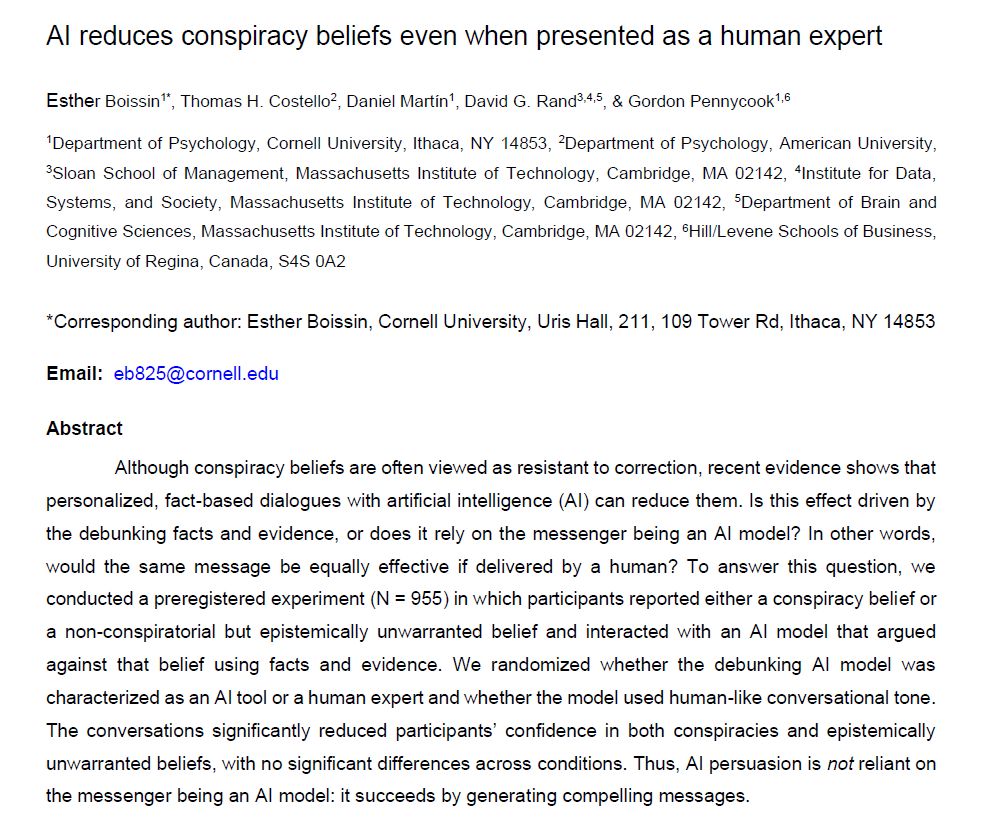
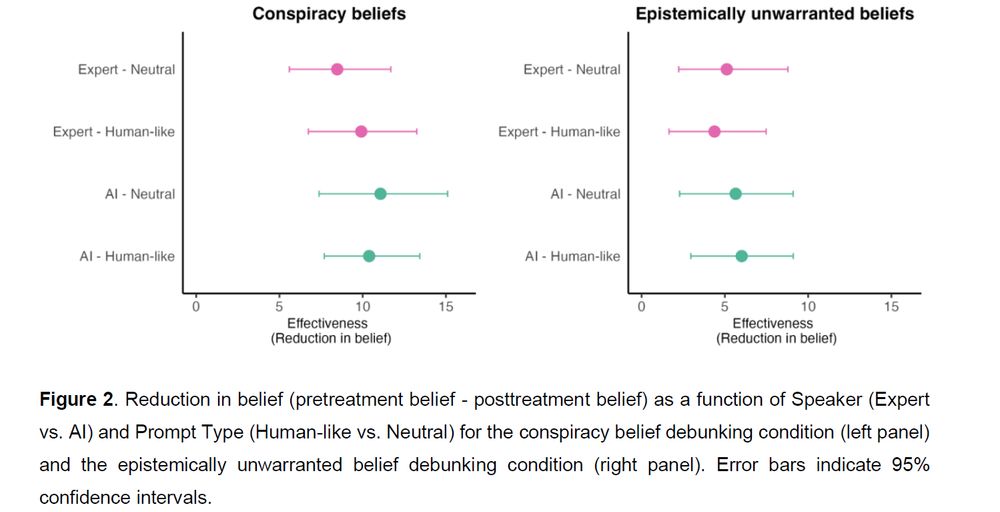
Recent research shows that AI can durably reduce belief in conspiracies. But does this work b/c the AI is good at producing evidence, or b/c ppl really trust AI?
In a new working paper, we show that the effect persists even if the person thinks they're talking to a human: osf.io/preprints/ps...
🧵
15.05.2025 15:54 — 👍 151 🔁 48 💬 8 📌 10
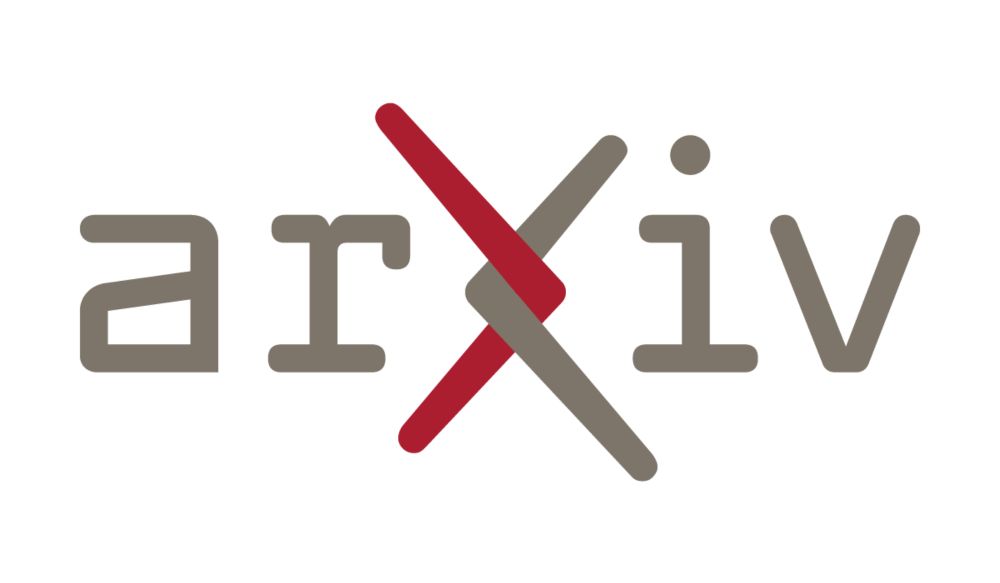
Moving towards informative and actionable social media research
Social media is nearly ubiquitous in modern life, and concerns have been raised about its putative societal impacts, ranging from undermining mental health and exacerbating polarization to fomenting v...
New preprint with @jbakcoleman.bsky.social @lewan.bsky.social @randomwalker.bsky.social @orbenamy.bsky.social @lfoswaldo.bsky.social where we argue for a complex-system perspective to understand the causal effects of social media on society and for a triangulation of methods
arxiv.org/abs/2505.09254
15.05.2025 06:31 — 👍 76 🔁 28 💬 2 📌 3
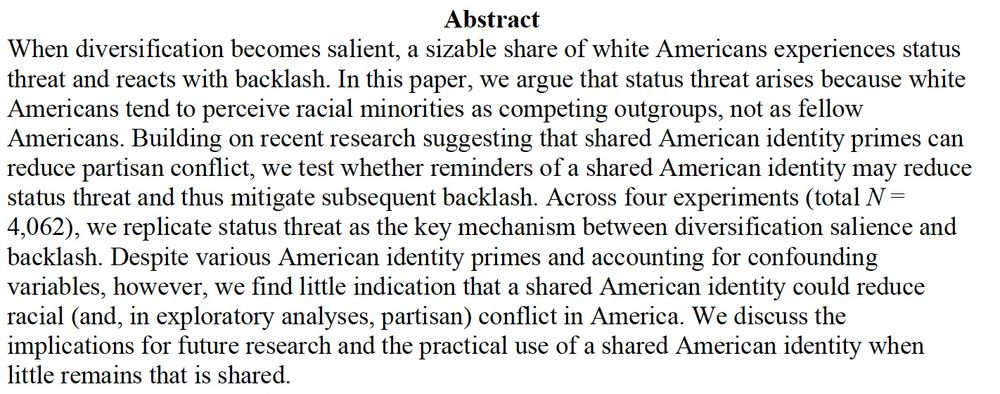
🚨 “We just need to recognize that we’re all citizens of this country.” –– Politicians + citizens often stress a shared national identity when trying to bridge racial, partisan, or other group divides.
@stysyropoulos.bsky.social & I show why such “shared” identities are doomed to fail.
🧵1/9
12.05.2025 07:07 — 👍 157 🔁 47 💬 11 📌 23
Professor of Comparative Democratic Institutions, Nuffield & University of Oxford, FBA. http://benansell.substack.com. Why Politics Fails. BBC Reith Lecturer 2023. Host of BBC Radio 4’s Rethink. Director, Centre for Advanced Social Science Methods (CASSM).
Professor of the Political Economy of Europe at LSE. Interested in democratic representation and inequality, worried about the survival of democracy. Author of Anti-System Politics (OUP, 2020). Also random thoughts on football, cycling, the weather etc
PhD researcher at the University of Amsterdam | Studying digital infrastructures, power and media in Europe | No business as usual during genocide 🇵🇸 | he/him
PhD Student Political Science Aarhus University | Interested in Political Parties & Issue Competition | prev. MA Social Sciences HU Berlin, BA Political Science FU Berlin, student assistant Manifesto Project at WZB Berlin, methods chair FU sociology dept
Political Science at Columbia, Editor Post-Soviet Affairs, Political economy, autocracy, and the NBA, and not always in that order. Most recently, Weak Strongman: The Limits of Power in Putin's Russia.
R, data, 🐕, 🍸, 🌈. He/him.
Automatically tweets new posts from http://statmodeling.stat.columbia.edu
Please respond in the comment section of the blog.
Old posts spool at https://twitter.com/StatRetro
Professor of Religion and Jewish Studies, Sarah Lawrence College. PhD in Religious Studies, University of Chicago. Globalist elite and Thing-in-Itself-hating Jew. Husband of @petticoatshrink.bsky.social. He/Him/הוא/ער
SNF Ambizione Fellow @ the Cognitive Psychology Lab, University of Zurich. Working on Psychometrics, Cognitive Modeling & Individual Differences.
Co-Developer of bmm: R package for Bayesian Measurment Models: https://github.com/venpopov/bmm
Assistant Professor @univie.ac.at丨Previously @ipz.bsky.social & @eui-sps.bsky.social丨Political Economy and Comparative Politics | www.retobuergisser.com
Asst Prof @CarnegieMellon • Health and Behavioral economist • Enjoy limericks, fantasy, and mezcal • also go by Vini
https://www.manasvinisingh.com/
(opinions mine)
Assistant Professor of Marketing Cornell SC Johnson College of Business, Past: FAIR/NHH Econ, Post Doc: CU-Boulder, PhD: Chicago Booth. Behavioral economics, financial decision making, coffee.
samhirshman.com
Behavioral economists at UC Berkeley
Research on digitalisation with a focus on innovation, regulation and democracy, at WZB, HIIG, Weizenbaum Institute, Berlin. Teaching at Freie Universität
Communication Scientist | PostDoc at ASCoR / AI Media Democracy Lab | Interested in the interplay of digital choice architectures and human decision making | Lover of good music, food and travelling
Cognitive and decision science at MPI for Human Development & Uni Basel | Data science at therbootcamp.github.io | R, language models, and sustainability (text2sdg.io).
Social-personality-political psychologist at the University of Illinois Chicago | Asian American(ist) | Lover of Chicago, public transportation, ramen, ube, dumplings, and more | Views are entirely my own
www.PBandJLab.com
Associate professor at Leiden University. Political economy, migration, welfare states 🇨🇭🇵🇹 🇳🇱 http://alexandreafonso.me
Professor of Political Communication and Journalism at the University of Amsterdam, ASCoR, Associated Researcher at Weizenbaum Institute Berlin. Technology & Democracy. Foodie. Traveller. Views are my own.































